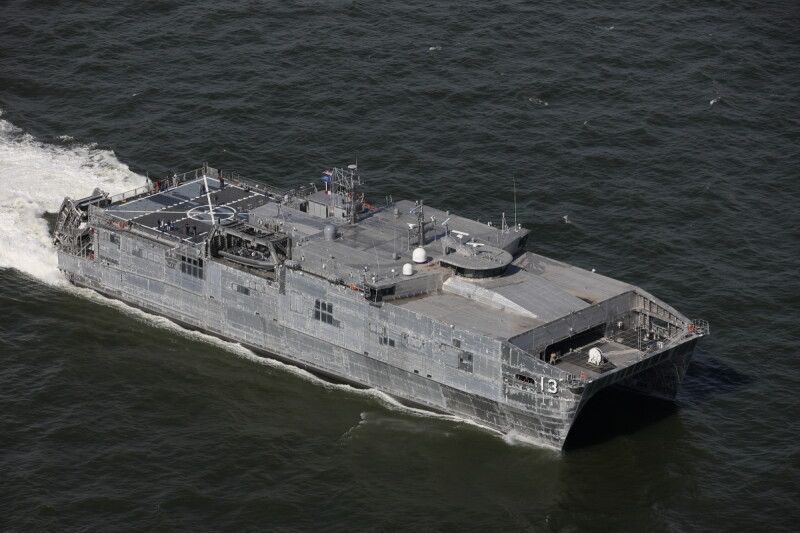Austal USA delivered the 338’x93’6” expeditionary fast transport vessel Apalachicola (EPF 13) to the Navy last week. This is the second Navy ship named after the coastal Florida city. Both ships were built in Mobile, Ala.
EPF 13 is now the largest surface ship in the Navy fleet with autonomous capability. EPF 13 went to sea five times allowing Austal USA and their industry partners, L3Harris and General Dynamics Mission Systems, to test and analyze not only its typical ship systems but those resulting from autonomous design and construction contract modifications required by the Navy to establish EPF 13 as an autonomous prototype.
“Austal USA is proud to deliver this ship to our Navy — it’s innovative and is going to be a critical asset as unmanned capabilities continue to push boundaries and redefine how missions are achieved,” Austal USA President Rusty Murdaugh said in a statement. “Apalachicola will also be the first EPF with the ability to conduct V-22 flight operations and launch and recover 11 meter rigid hull inflatable boats (RHIBs). A lot of capability is being delivered to our warfighters with this ship and I’m incredibly proud of our team of shipbuilders.”
With a shallow draft and high-speed, the EPF’s agility provides a positional advantage in the littorals and makes it an ideal candidate to prototype large vessel autonomous operations, including logistics, tendering and adjunct magazine mission profiles, the Navy said.
Fundamental to the autonomy effort was Austal USA’s highly automated in-house designed machinery control system (MCS), which allows the ship to be minimally manned by centralizing machinery operations to the bridge, Austal said. All Spearhead-class EPFs incorporate the Austal USA MCS design which is designed to be secure, scalable, distributive and reconfigurable for multiple propulsion configurations.
Combined with the already highly automated hull, mechanical & electrical systems installed on EPF class ships, Austal USA added automated maintenance, health monitoring, and mission readiness to provide EPF 13 with the capability to conduct up to 30 days of operation without human intervention.
EPF 13 is also the first EPF to be delivered to the Navy with enhanced capabilities to support V-22 flight operations and launch and recover 11-meter RHIBs. These upgrades along with EPF’s speed, maneuverability and shallow water access are key enablers for support of future expeditionary advanced base operations around the world, the Navy said
Autonomous vessel capability has been identified as an area of strategic importance by the Navy. Austal USA is working to advance autonomous capability and is partnered with L3Harris on the MCS upgrade of Overlord vessel, Mariner (OUSV 3), and construction of Vanguard (OUSV 4), and with Saildrone Inc. on the manufacture of Surveyor unmanned surface vehicles.
The 338’x93’6” Apalachicola is part of the Military Sealift Command’s Sealift Program. Apalachicola is the 13th EPF, formerly known as joint high-speed vessels, the first of which was delivered by Austal USA in 2012.
The catamaran vessels have performed humanitarian assistance, disaster relief, maritime security, surveillance, command and control, counter narcotics, and additional operations around the world.
Main propulsion comes from four MTU 20V8000 diesel engines that turn four Wärtsilä steerable, reversing waterjets through four ZF 60000 NRTH gearboxes, giving the Apalachicola a speed of 33 knots with 380 metric tonnes of cargo, 21 knots with a mission payload of 231 metric tonnes of medical cargo, and 10 knots in sea state 5.
Other features include a crew of 36; a medical detachment that boats three VIPs, one officer in charge, eight isolation/acute care medical beds, two operating rooms (one major and one minor procedure), 23 medical ward beds, 10 CU beds, and eight isolation/acute care beds; an 11-meter (36') RIB launch and recovery system; and a hydraulic paint boom.
Austal USA is currently building the future Point Loma (EPF 15). The shipyard is also building several littoral combat ships (LCS) for the Navy at its Gulf Coast shipyard.




